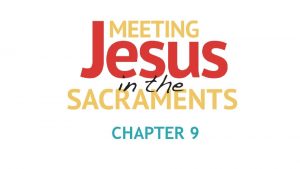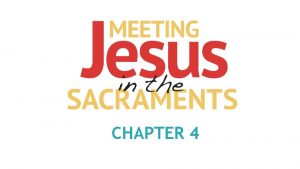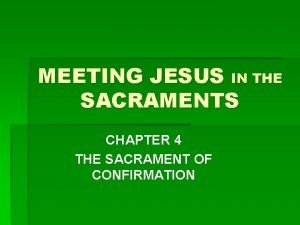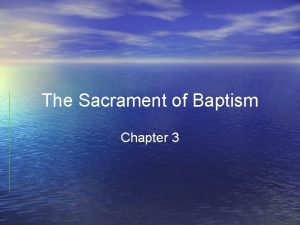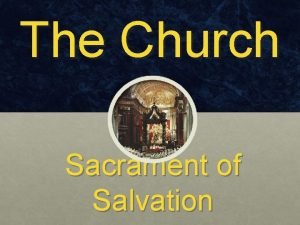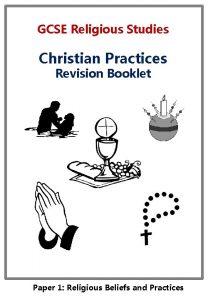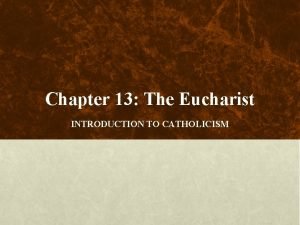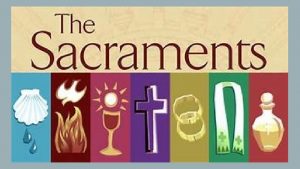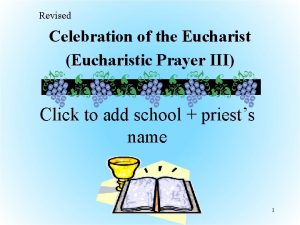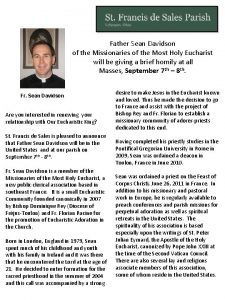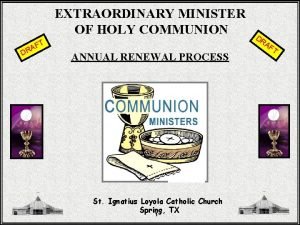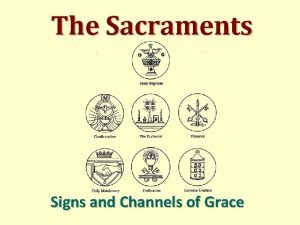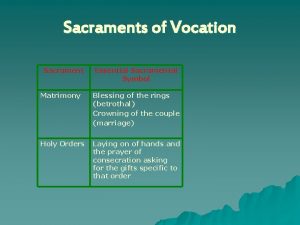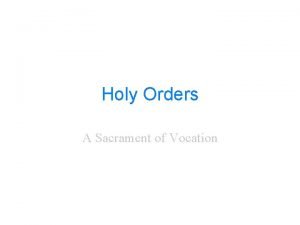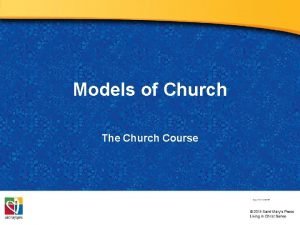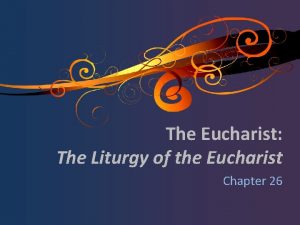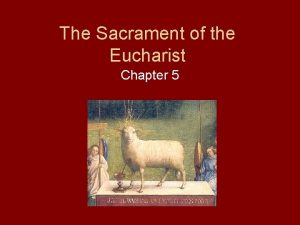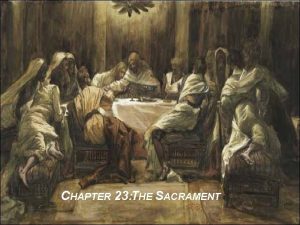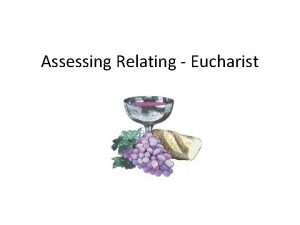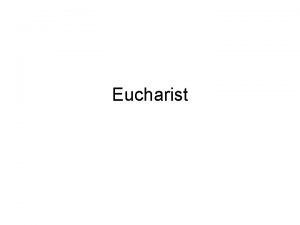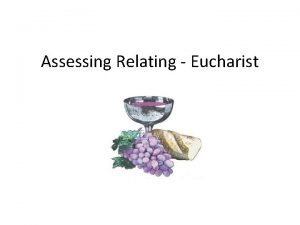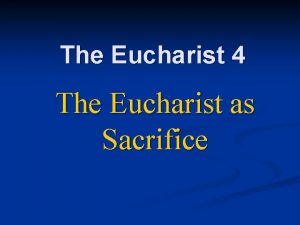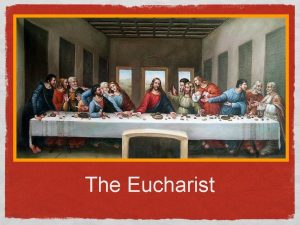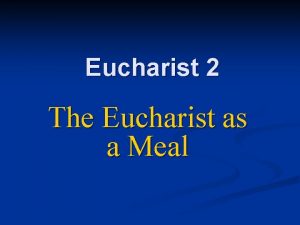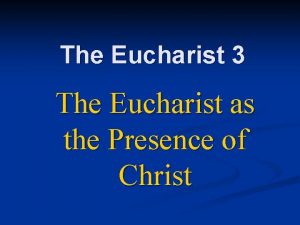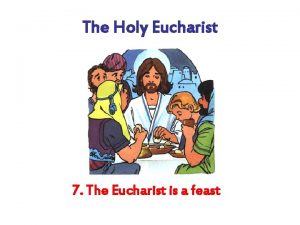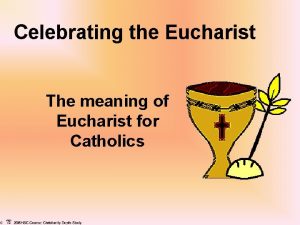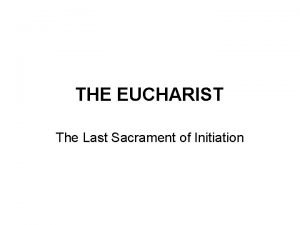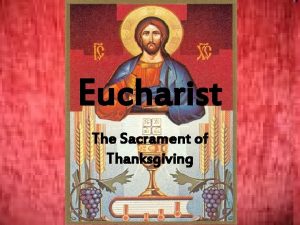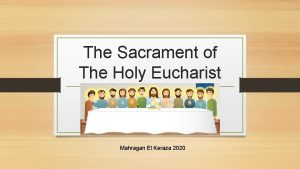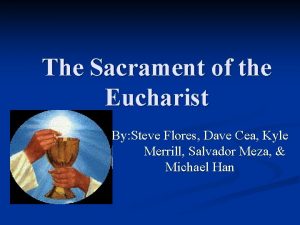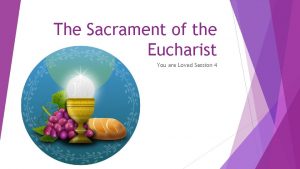CHAPTER 5 Chapter 4 The Sacrament of Eucharist





















- Slides: 21

CHAPTER 5

Chapter 4 The Sacrament of Eucharist

The Eucharist is the “source and summit of the Christian Life” (Lumen Gentium, 11) Understanding the Sacrament of the Eucharist

Fruits of the Earth and Vine The signs of bread and wine signify the goodness of God’s creation. In the Offertory at Mass, the priest remembers the blessing of bread and wine that God has bestowed on the Church. Understanding the Sacrament of the Eucharist


References to Bread and Wine in the Bible Old Testament Reference New testament fulfillment Melchizedek of Salem offered bread and wine to Abraham. Jesus is described as a “priest” according to the order of Melchizedek. Bread and wine are fulfillment under the old Law. Bread and wine offered as sacrifice among the first fruits of the Church. Jesus multiplied loaves and fish. Jesus took the several loaves and the fish, gave thanks, broke the loaves, and gave them to his disciples Israelites ate manna in the desert commemorating their liberation. “Your fathers ate manna in the desert and they are dead; but this is the bread which comes down from heaven, so that a person may eat it and not die. (Jn 6: 49 -50) In the New Covenant, Jewish Passover ended in “cup of blessing. ” “The blessing-cup, which we bless, is it not a sharing in the blood of Christ; and the loaf of bread which we break, is it not a sharing in the body of Christ? ” (1 Cor 10: 16)

Second Coming of Jesus Christ Also known as the Parousia; the time when Jesus will return to earth, the Kingdom of God will be fully established, and victory over evil will be complete. Understanding the Sacrament of the Eucharist

Tridentine Mass (Traditional Latin Mass) Missal of Pope Paul VI Priest and congregation face same direction (ad orientem) Celebrated versus populum—facing the people as standard practice. Ad orientem is still normative Altar attached to back wall of church, raised up three steps, called ”the high altar” A “low altar” is typically in the middle of the sanctuary Celebrated in Latin—the normative for both masses Celebrated in the vernacular Reading of Scripture and distribution of Communion reserved to the priest Laity has taken on a greater role as lectors and Eucharistic ministers Males serve as altar boys St. John Paul II allowed for female servers, leaving it up to each bishop Gregorian Chant All forms of music A rail separates sanctuary from the rest of church A rail is not present in modern churches or was removed Kneel at altar rail to receive communion on tongue Receive communion standing in either species on tongue or in hand Dismissal and blessing followed by last gospel reading John 1: 1 -14 Dismissal and blessing Understanding the Sacrament of the Eucharist

Nicene Creed The formal Profession of Faith recited at Mass. It came from the first two ecumenical councils, at Nicaea in 325 and Constantinople in 381. The councils came about to dispel the heresy Arius, a priest in Alexandria, Egypt was spreading that discounted the divinity of Jesus. Arius claimed that if Jesus was begotten by God the Father, he must have had a beginning and an end and was, therefore, not fully God. The Blessed Trinity was long referenced by Jesus in Scripture, as well as many Church fathers from the first century A. D. onward Understanding the Sacrament of the Eucharist

Second Vatican Council The Church should never depart from the sacred treasure of truth inherited from the Fathers. But at the same time she must ever look to the present, to the new conditions and the new forms of life introduced into the modern world. Understanding the Sacrament of the Eucharist

Doxology comes from the Greek doxa which means glory • “Through him, and with him, and in him; O God, almighty Father; in the unity of the Holy Spirit; all glory and honor is yours; for ever and ever. ” Understanding the Sacrament of the Eucharist

Transubstantiation What happens at the consecration of the bread and wine at Mass when their entire substance is turned into the entire substance of the Body and Blood of Christ, even though the appearances of bread and wine remain. The Eucharistic presence of Christ begins at the moment of consecration and endures as long as the Eucharistic species subsist Understanding the Sacrament of the Eucharist

Obligations as Catholics Precepts of the Church 1. You shall attend Mass on Sundays and on holy days of obligation and rest from servile labor. 2. You shall confess your sins at least once a year. 3. You shall receive the Sacrament of the Eucharist at least during the Easter season. 4. You shall observe the days of fasting and abstinence established by the Church. 5. You shall help to provide for the needs of the Church. Understanding the Sacrament of the Eucharist

Viaticum The Eucharist received by a dying person. This is a Latin term that means “food for the journey. ” Understanding the Sacrament of the Eucharist

The Order of the Mass • Introductory Rites • • • Entrance (Introit is sung) Greeting Penitential Rite Kyrie (Lord, Have Mercy) Gloria (Glory to God) Collect (Opening Prayer) • Liturgy of the Word • • First Reading Responsorial Psalm Second Reading Gospel acclamation (Alleluia) Gospel Homily Profession of Faith (Nicene Creed) Universal Prayer (Prayer of the Faithful)

Liturgy of the Eucharist • Presentation of the Gifts and Preparation of the Altar • Prayer over the Offerings • Eucharistic Prayer • • • Preface Holy, Holy (Sanctus) First half of prayer, including consecration Memorial Acclamation (Anamnesis) Second half of prayer, ending with the doxology • Communion Rite • • • The Lord’s Prayer Rite of Peace Lamb of God (Fraction Rite) Communion Prayer after Communion Understanding the Sacrament of the Eucharist

Wine water White Garment Liturgical Signs and Symbols Fire/Light Bread Oil Understanding the Sacrament of the Eucharist

Eucharistic Prayer The Church’s great prayer of praise and thanksgiving to God that takes place during the Liturgy of the Eucharist. There are four main Eucharistic Prayers in the Roman Rite. Understanding the Sacrament of the Eucharist

Graces of Receiving Eucharist • Unity with Christ • Separation from sin • Becoming united with others Understanding the Sacrament of the Eucharist

Eucharistic Adoration • Species of Jesus in unleavened bread kept in monstrance. • Most parishes offer weekly times for Adoration. • Some parishes offer perpetual adoration. • A candle is kept lit next to the tabernacle at all times to show the light of Christ. • “To visit the Blessed Sacrament is a proof of gratitude, an expression of love, and a duty of adoration toward Christ our Lord” (Pope Paul VI). Understanding the Sacrament of the Eucharist

• http: //www. catholicnewsherald. com/faith/101 -news/faith/364 -thenicene-creed-and-its-origins • http: //www. togetheratonealtar. catholic. edu. au/craft/dspcontent. cfm? loadref=36 • http: //www. therealpresence. org/eucharst/vat/vere_2. htm
 Meeting jesus in the sacraments
Meeting jesus in the sacraments The sacrament of the eucharist chapter 5
The sacrament of the eucharist chapter 5 O sacrament most holy hymn
O sacrament most holy hymn The sacrament of matrimony chapter 9 crossword
The sacrament of matrimony chapter 9 crossword The sacrament of confirmation chapter 4
The sacrament of confirmation chapter 4 The sacrament of confirmation chapter 4
The sacrament of confirmation chapter 4 When do we renew our baptismal promises
When do we renew our baptismal promises The church sacrament of salvation chapter 3 study questions
The church sacrament of salvation chapter 3 study questions Christianity beliefs and practices
Christianity beliefs and practices What is a eucharist
What is a eucharist Matter in baptism
Matter in baptism Eucharist – year 10 religion
Eucharist – year 10 religion Penitential rite
Penitential rite Missionaries of the most holy eucharist
Missionaries of the most holy eucharist Eucharist multiple choice questions
Eucharist multiple choice questions Prayer for holy eucharist
Prayer for holy eucharist Consummate
Consummate The vocation sacraments are
The vocation sacraments are Sacrament of vocation
Sacrament of vocation Last supper golden ratio
Last supper golden ratio Sacraments of vocation
Sacraments of vocation Sacrament model of the church
Sacrament model of the church



